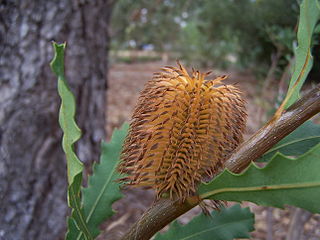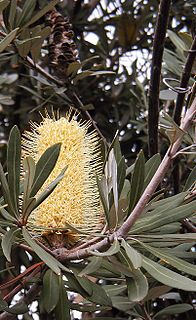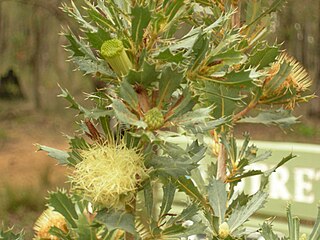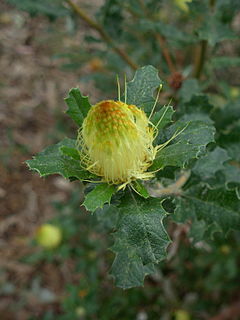Related Research Articles

Banksia ser. Quercinae is a valid botanic name for a series of Banksia. First published by Carl Meissner in 1856, the name has had three circumscriptions.

Banksia armata, commonly known as prickly dryandra, is a species of often sprawling shrub that is endemic to Western Australia. It has deeply serrated leaves with sharply pointed lobes and spikes of about 45 to 70 yellow flowers.

Banksia fraseri is a species of shrub that is endemic to Western Australia. It has hairy stems, broadly linear pinnatisect leaves with between four and eighteen sharply-pointed lobes on each side, between eighty and one hundred pink to cream-coloured flowers and wege-shaped follicles.

Banksia horrida, commonly known as prickly dryandra, is a species of shrub that is endemic to Western Australia. It has hairy stems, linear, pinnatifid leaves with sharply pointed teeth on the edges, up to sixty cream-coloured flowers in each head and hairy, egg-shaped follicles.

Banksia splendida, commonly known as shaggy dryandra, is a species of shrub that is endemic to the southwest of Western Australia. It has sharply-pointed linear leaves that are woolly on the lower surface, cream-coloured and maroon or yellow flowers in heads of between 65 and 115, and later up to eight egg-shaped follicles in each head.
Dryandra subg. Diplophragma is an obsolete subgenus within the former genus Dryandra. It was first published by Robert Brown in 1830, but was discarded by George Bentham in 1870. It was reinstated with a new circumscription by Alex George in 1996, but was ultimately discarded again in 2007 when Austin Mast and Kevin Thiele sunk Dryandra into Banksia.

Banksia armata var. armata is a variety of shrub that is endemic to Western Australia. It differs from the other variety in having a lignotuber, narrower leaves with more side lobes and shorter flowers. It is also usually a shorter plant.
Carl Meissner's taxonomic arrangement of Banksia was published in 1856, as part of his chapter on the Proteaceae in A. P. de Candolle's Prodromus systematis naturalis regni vegetabilis. It was the first attempt to provide an infrageneric classification for the genus, aside from Robert Brown's publication of two subgenera in 1810. Meissner's arrangement stood until 1870, when it was superseded by the arrangement of George Bentham. Meissner's arrangement was an excellent survey of the known species at that time, but his infrageneric taxa were all highly heterogeneous.

Banksia sect. Eubanksia is an obsolete section of Banksia. There have been two circumscriptions, one of which is synonymous with the recently abandoned B. subg. Banksiasensu Alex George, the other having no modern equivalent.

Alex George's taxonomic arrangement of Dryandra was the first modern-day arrangement of that taxon. First published in Nuytsia in 1996, it superseded the arrangement of George Bentham, which had stood for over a hundred years; it would later form the basis for George's 1999 treatment of Dryandra for the Flora of Australia. In accordance with contemporary thinking, George treated Dryandra as a genus, dividing it into three subgenera, the largest of which was divided into 24 series. The arrangement stood until 2007, when Dryandra was transferred into Banksia as B. ser. Dryandra. No alternative has yet been proposed.
Robert Brown's taxonomic arrangement of Dryandra was the first arrangement of what is now Banksia ser. Dryandra. His initial arrangement was published in 1810, and a further arrangement, including an infrageneric classification, followed in 1830. Aspects of Brown's arrangements can be recognised in the later arrangements of George Bentham and Alex George.

George Bentham's taxonomic arrangement of Dryandra was published in 1870, in Volume 5 of Bentham's Flora Australiensis. It replaced the 1856 arrangement of Carl Meissner, and stood for over a century before being replaced by the 1996 arrangement of Alex George.

Dryandra subg. Hemiclidia is an obsolete plant taxon that encompassed material that is now included in Banksia. Published at genus rank as Hemiclidia by Robert Brown in 1830, it was set aside by George Bentham in 1870, but reinstated at subgenus rank by Alex George in 1996. In 2007, all Dryandra species were transferred into Banksia at series rank, and the infrageneric Dryandra taxa, including D. subg. Hemiclidia, were set aside.
Dryandra ser. Niveae is an obsolete series within the former genus Dryandra. It was first published by George Bentham in 1870, and was given a new circumscription by Alex George in 1996, but was ultimately discarded in 2007 when Austin Mast and Kevin Thiele sunk Dryandra into Banksia.

Dryandra subg. Dryandra is an obsolete clade of plant. It was a series within the former genus Dryandra. The name was first published at sectional rank as Dryandra verae in 1830, before being renamed Eudryandra in 1847, the replaced by the autonym at subgenus rank in 1996. It was ultimately discarded in 2007 when Austin Mast and Kevin Thiele sunk Dryandra into Banksia.

Dryandra ser. Floribundae is an obsolete series within the former genus Dryandra. It was first published by George Bentham in 1870, and was given a new circumscription by Alex George in 1996, but was ultimately discarded in 2007 when Austin Mast and Kevin Thiele sunk Dryandra into Banksia.

Dryandra ser. Ilicinae is an obsolete series within the former genus Dryandra. It was first published by Carl Meissner in 1856, but was discarded by George Bentham in 1870. It was reinstated with a new circumscription by Alex George in 1996, but was ultimately discarded again in 2007 when Austin Mast and Kevin Thiele sunk Dryandra into Banksia.

Dryandra ser. Aphragma is an obsolete series within the former genus Dryandra. It was first published at sectional rank by Robert Brown in 1830, and was retained at that rank until 1999, when Alex George demoted it to a series. It was discarded in 2007 when Austin Mast and Kevin Thiele sank Dryandra into Banksia.
References
- 1 2 3 Meissner, Carl (1856). "XLIV. Dryandra". In de Candolle, A. P. (ed.). Prodromus systematis naturalis regni vegetabilis . Vol. XIV. Paris: Sumptibus Sociorum Treuttel et Wurtz. pp. 467–481.
- 1 2 3 Meissner, Carl (1856). "XLV. Hemiclidia". In de Candolle, A. P. (ed.). Prodromus systematis naturalis regni vegetabilis . Vol. XIV. Paris: Sumptibus Sociorum Treuttel et Wurtz. pp. 481–482.
- ↑ Brown, Robert (1810). Prodromus Florae Novae Hollandiae et Insulae Van Diemen . London: Taylor.
- ↑ Brown, Robert (1830). Supplementum Primum Prodromi Florae Novae Hollandiae . London: Taylor. pp. 37–40.
{{cite book}}: CS1 maint: multiple names: authors list (link) - ↑ Bentham, George (1870). "Dryandra". Flora Australiensis . Vol. 5. London: L. Reeve & Co. pp. 562–584.
- ↑ George, Alex S. (1996). "New taxa and a new infragenetic classification in Dryandra R.Br. (Proteaceae: Grevilleoideae)". Nuytsia . 10 (3): 313–408.
- ↑ Mast, A. R. and Kevin Thiele (2007). "The transfer of Dryandra R.Br. to Banksia L.f. (Proteaceae)". Australian Systematic Botany . 20: 63–71. doi:10.1071/SB06016.